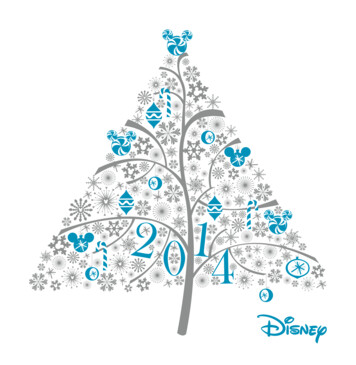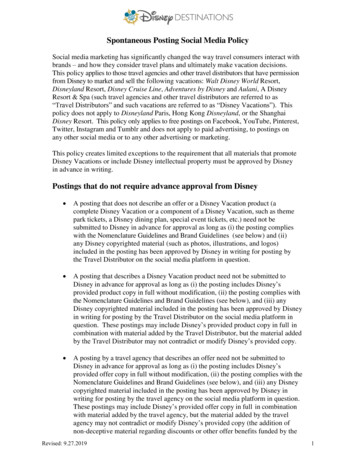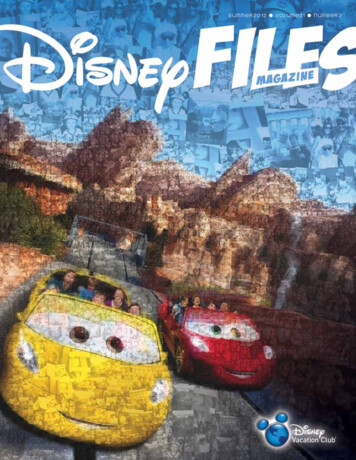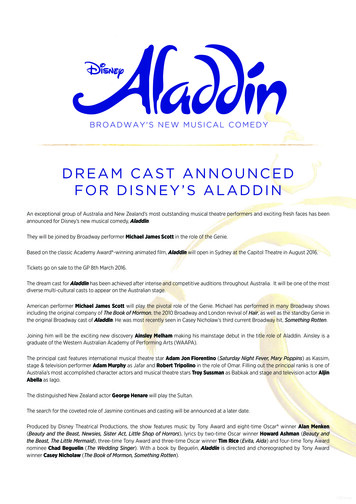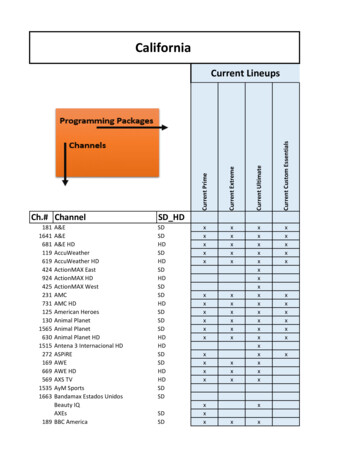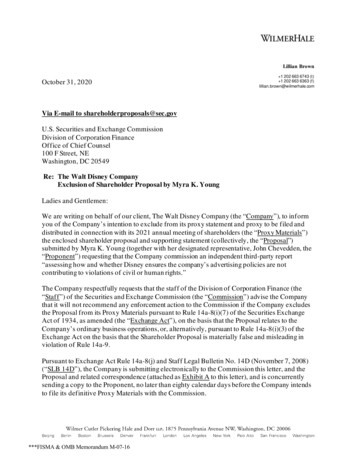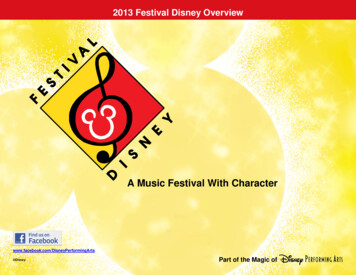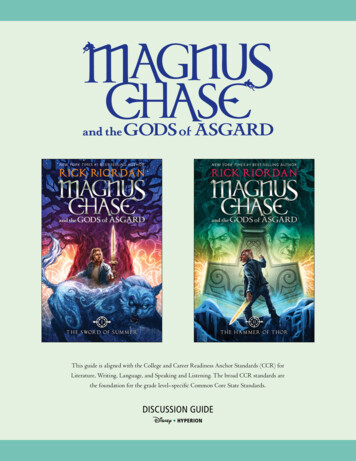
Transcription
This guide is aligned with the College and Career Readiness Anchor Standards (CCR) forLiterature, Writing, Language, and Speaking and Listening. The broad CCR standards arethe foundation for the grade level–specific Common Core State Standards.DISCUSSION GUIDEDisney HYPERION3
A bout the BooksThe Sword of SummerM agnus Chase and the Gods of A sgard, Book 1Magnus Chase has always been a troubled kid. Since his mother’s mysteriousdeath, he’s lived alone on the streets of Boston, surviving by his wits, keepingone step ahead of the police and the truant officers. One day, he’s tracked downby an uncle he barely knows — a man his mother claimed was dangerous. UncleRandolph tells him an impossible secret: Magnus is the son of a Norse god.The Viking myths are true. The gods of Asgard are preparing for war. Trolls,giants, and worse monsters are stirring for doomsday. To prevent Ragnarok,Magnus must search the Nine Worlds for a weapon that has been lost forthousands of years. When an attack by fire giants forces him to choosebetween his own safety and the lives of hundreds of innocents, Magnus makesfatal decision.Sometimes, the only way to start a new life is to die. . . .The H ammer of ThorM agnus Chase and the Gods of A sgard, Book 2Thor’s hammer is missing again. The thunder god has a disturbing habit ofmisplacing his weapon— the mightiest force in the Nine Worlds. But this timethe hammer isn’t just lost; it has fallen into enemy hands. If Magnus Chaseand his friends can’t retrieve the hammer quickly, the mortal worlds will bedefenseless against an onslaught of giants. Ragnarok will begin. The NineWorlds will burn. Unfortunately, the only person who can broker a deal forthe hammer’s return is the gods’ worst enemy, Loki — and the price he wantsis very high.2a
Who’s WhoAegir: lord of the wavesAesir: gods of war, close to humansAlf seidr: elf magicAndskoti: the Adversary; the new, magic-infused ropebinding Fenris the WolfBalder: god of light; the second son of Odin and Frigg,and twin brother of Hod. Frigg made all earthly thingsswear to never harm her son, but she forgot about mistletoe.Loki tricked Hod into killing Balder with a dart made ofmistletoe.Bifrost: the rainbow bridge leading from Asgardto MidgardDraugr: Norse zombiesEikthrymir: a stag in the Tree of Laeradr whose hornsspray water nonstop that feeds every river in every worldEinherjar (Einherji, sing.): great heroes who havedied with bravery on Earth; soldiers in Odin’s eternal army.They train in Valhalla for Ragnarok, when the bravest ofthem will join Odin against Loki and the giants in the battleat the end of the world.Fenris Wolf: an invulnerable wolf born of Loki’s affairwith a giantess. His mighty strength strikes fear even inthe gods, who keep him tied to a rock on an island. He isdestined to break free on the day of Ragnarok.Folkvanger: the Vanir afterlife for slain heroes, ruledby the goddess FreyaFrey: the god of spring and summer; the sun, the rain, andthe harvest; abundance and fertility; growth and vitality.Frey is the twin brother of Freya and, like his sister, isassociated with great beauty. He is lord of Alfheim.Freya: the goddess of love; twin sister of Frey;ruler of FolkvangerFrigg: goddess of marriage and motherhood; Odin’s wifeand the queen of Asgard; mother of Balder and HodGinnungagap: the primordial void; a mist thatobscures appearancesGleipnir: a rope made by dwarves to keep Fenris Wolfin bondageHeidrun: the goat in the Tree of Laeradr whose milkis brewed for the magical mead of ValhallaHeimdall: god of vigilance and the guardian of Bifrost,the gateway to Asgard3
Hel: goddess of the dishonorable dead; born of Loki’saffair with a giantessIdun: a goddess who distributes the apples of immortalitythat keep the gods young and spry.Helheim: the underworld, ruled by Hel and inhabitedby those who died in wickness, old age, or illnessHlidskjalf: the High Seat of OdinJormungand: the World Serpent, born of Loki’saffair with a giantess, whose body is so long it wrapsaround the earthHod: Balder’s blind brotherJotun: giantHonir: an Aesir god who, along with Mimir, tradedplaces with Vanir gods Frey and Njord at the end of thewar between the Aesir and the VanirLoki: god of mischief, magic, and artifice; the son oftwo giants; adept at magic and shape-shifting. He isalternately malicious and heroic to the Asgardian gods andto humankind. Because of his role in the death of Balder,Loki was chained by Odin to three giant boulders with apoisonous serpent coiled over his head. The venom of thesnake occasionally irritates Loki’s face, and his writhing isthe cause of earthquakes.Lyngvi: the Isle of Heather, where Fenris Wolf is bound.The island’s location shifts every year as the branches ofYggdrasil sway in the winds of the void. It only surfacesduring the first full moon of the year.Magni and Modi: Thor’s favorite sons, fated tosurvive RagnarokMimir: an Aesir god who, along with Honir, tradedplaces with Vanir gods Frey and Njord at the end of the warbetween the Aesir and the Vanir. When the Vanir didn’t likehis counsel, they cut off his head and sent it to Odin. Odinplaced the head in a magical well, where the water brought itback to life, and Mimir soaked up all the knowledge of theWorld Tree.Mjolnir: Thor’s hammerMuspell: fireNaglfar: the Ship of NailsNarvi: one of Loki’s sons, disemboweled by his brotherVali, who was turned into a wolf after Loki killed BalderNidhogg: the dragon that lives at the bottom of theWorld Tree and chews on its rootsNjord: god of ships, sailors, and fishermen; father of Freyand FreyaNorns: three sisters who control the destinies of bothgods and humansHearthstone4
Norumbega: a lost Norse settlement in their farthestpoint of explorationTyr: god of courage, law, and trial by combat. He lost a handto Fenris’s bite when the Wolf was restrained by the gods.Odin: the “All-Father” and king of the gods; the god ofwar and death, but also poetry and wisdom. By trading oneeye for a drink from the Well of Wisdom, Odin gainedunparalleled knowledge. He has the ability to observe allthe Nine Worlds from his throne in Asgard; in addition tohis great hall, he also resides in Valhalla with the bravest ofthose slain in battle.Uller: the god of snowshoes and archeryUtgard-Loki: the most powerful sorcerer of Jotunheim;king of the mountain giantsVala: a seerValhalla: paradise for warriors in the serviceof OdinRagnarok: the Day of Doom or Judgment, when thebravest of the einherjar will join Odin against Loki and thegiants in the battle at the end of the worldVali: Loki’s son, who was turned into a wolf after Lokikilled Balder. As a wolf he disemboweled his brother Narvibefore he was gutted himself.Ran: goddess of the sea; wife of AegirValkyrie: Odin’s handmaidens, who choose slain heroesto bring to ValhallaRatatosk: an invulnerable squirrel that constantly runsup and down the World Tree carrying insults between theeagle that lives at the top and Nidhogg, the dragon that livesat the rootsRed gold: the currency of Asgard and ValhallaSaehrimnir: the magical beast of Valhalla. Every dayit is killed and cooked for dinner, and every morning it isresurrected; it tastes like whatever the diner wants.Vanir: gods of nature; close to elvesYggdrasil: the World TreeYmir: the largest of the giants; father to both the giantsand the gods. He was killed by Odin and his brothers, whoused his flesh to create Midgard. This act was the genesis ofthe cosmic hatred between the gods and the giants.Sessrumnir: the Hall of Many Seats, Freya’s mansionin FolkvangerSkirnir: a god; Frey’s servant and messengerSleipnir: Odin’s eight-legged steed; only Odin cansummon him; one of Loki’s childrenSumarbrander: the Sword of SummerSurt: lord of MuspellheimSvartalf: dark elf, a subset of dwarvesThane: a lord of ValhallaThor: god of thunder; son of Odin. Thunderstorms arethe earthly effects of Thor’s mighty chariot rides across thesky, and lightning is caused when he hurls his great hammer,Mjolnir.Tree of Laeradr: a tree in the center of the Feast Hallof the Slain in Valhalla containing immortal animals thathave particular jobsBlitzen5
The Nine WorldsAsgard: the home of the AesirNidavellir: the home of the dwarvesVanaheim: the home of the VanirNiflheim: the world of ice, fog, and mistAlfheim: the home of the light elvesMuspellheim: the home of the fire giants and demonsMidgard: the home of humansHelheim: the home of Hel and the dishonorable deadJotunheim: the home of the giantsPre-R eading ActivitySince the pantheon of Norse lore may not be as familiar to students as Greek, Roman, or Egyptian mythology, considerbuilding background information for students using the following activity.Instructions for StudentsTo build a foundation for understanding the Magnus Chase and the Gods of Asgard series,work independently or with a small group to contribute to a “Who’s Who of NorseMythology” exhibit. Utilize the lists of Norse gods, monsters, and creatures providedin the books’ glossaries and select a research topic. Using the Internet and libraryresources, create a “biography” of your chosen mythological figurethat includes the following: Physical description Relationship to other important Norse characters Explanation of any significant connections to othermythological figures Any other important information (such as specialabilities or powers)You or your team should prepare a digital exhibitwith a poster or slide show designed to informothers about your mythological figure as a meansof creating background knowledge for the reading ofThe Sword of Summer or The Hammer of Thor.Samirah6
Exploring through Discussion and WritingThe following questions may be used throughout the study of the Magnus Chase and the Gods of Asgard series, as targetedquestions for class discussion and reflection. Alternatively they can be used to as reflective writing prompts.The Sword of Summer Questions1 In the opening of The Sword of Summer, Magnus states, “Yeah, I know. You guys are going to read about how I died inagony, and you’re going be like, ‘Wow! That sounds cool, Magnus! Can I die in agony too?’” How does learning thatMagnus dies set the tone for the novel? In what ways is learning this fact about his fate unique?2 Early in the novel, readers learn that Magnus has been homeless for the past couple of years. He shares, “I don’t needyour sympathy. I’m used to being laughed at. I’m definitely used to being ignored.” What do you think an experiencelike this has done to Magnus’s relationships with others and to his general attitude? How does Magnus changethroughout the course of the novel?3 While thinking about his mother, Magnus shares, “After two years, my memories of her were still a minefield. Istumbled over one, and instantly my composure was blown to bits.” Why do his memories of his mother have sucha profound effect on him? What can be inferred about his relationship with his mom?4 Magnus shares, “Surt’s heat didn’t make me pass out. It just made me angry. I didn’t know who this fiery jack-hole was,but I knew a bully when I met one. First rule of the streets: Never let a bully take your stuff.” Why does Magnus notinitially understand the magnitude of danger he faces?5 The author uses some unusual titles and first lines to introduce the chapters. Which of them is your favorite? Forwhat reason?6 The last thing Magnus’s mother told him was, “Magnus, run. Hide. Don’t trust anyone. I’ll find you. Whatever you do,don’t go to Randolph for help.” Why do you think she was so adamant that he stay away from his uncle? What did shefear for Magnus?7 What were your first impressions of Blitz and Hearth? Were you surprised to learn who and what they are? Whatmakes this duo so important to Magnus? In what ways do they prove themselves to be heroic?8 Why do you believe Magnus awakens in the Grove of Glasir? What about this space allows him to feel comfortable?9 What is it about Hotel Valhalla that Magnus finds so unusual? In your opinion, what are the best parts? What arethe worst? Do you believe Magnus is really worthy of a place there?10 Describe the Valkyries Gunilla and Sam. What are three things that you find most (or least) appealing abouteach of them? Are there any similarities between the two? What roles do you expect the Valkyries will play in furthervolumes of Magnus Chase and the Gods of Asgard?7
11 Consider the list of favorite fantasy and horror authors Magnus mentions: Stephen King, Darren Shan, NealShusterman, Michael Grant, and Joe Hill. Are you familiar with the work of any of these writers? If so, is theresomething written by them that you would recommend?12 W hy is Sam so distrusted by some of those in Valhalla? Do you believe they are right to feel that way? To whatdegree are we all really products of our families?13 Magnus states, “In the old stories, Valhalla was for heroes who died in battle. I remembered that much. I definitelydidn’t feel like a hero.” Why does Magnus feel himself unworthy of an afterlife in Valhalla? Do you think he’s right tothink so? Why or why not?14 In your opinion, do T.J., Mallory Keen, Halfborn Gunderson, and X prove themselves worthy friends to Magnus? If so,in what ways? What do you predict their roles will be in the further adventures of Magnus Chase?15 T hroughout the course of the novel, Magnus learns that the world as he knows it may never be the same. In what wayswill it be better or worse for him? Have you had an experience that reshaped your life? In what ways have you changeddue to this incident?16 If you are familiar with Annabeth Chase from the Percy Jackson or Heroes of Olympus series, do you see any similaritiesbetween Magnus and his cousin? In what ways are they different? In what ways will having a closer relationship withAnnabeth make life less challenging for Magnus?17 In what ways does Magnus’s distress about wolves make his task of keeping Fenris Wolf bound so challenging? Whatare some things you believe he can do to overcome this fear?18 The Sword of Summer features a number of characters who exhibit a variety of strengths. Who most impresses you withtheir skills or gifts? Explain your choice.19 Consider the conclusion of The Sword of Summer and predict what adventures and obstacles will be in store for Magnusin the next installment of Magnus Chase and the Gods of Asgard.Questions for The H ammer of Thor1 In the opening of The Hammer of Thor, Magnus considers how his life has changed, “Last March, I had been scroungingfrom Dumpsters. I’d been sleeping under a bridge in the Public Garden, hanging out with my buddies Hearth andBlitz, avoiding the cops and just trying to stay alive. . . . Now I had clean clothes. I took a shower every day. I slept in acomfortable bed every night. I could sit at this café table, eating food I’d actually paid for, and not worry about when thestaff would force me to move along.” Besides these noted changes, what are the other significant ways in which Magnus’slife is different now?2 Before his death, Magnus was homeless and regularly ignored or avoided. In what ways do those past experiences fromhis life make his time at Hotel Valhalla somewhat challenging? What are the biggest lessons he has to learn upon arrival,and how do those experiences shape the warrior he becomes?8
3 In what ways does knowing that his cousin Annabeth has had her own adventures and challenges with gods makeMagnus feel a kinship with her? From what you have observed so far, how would you describe their bond?4 What makes Sam’s relationship with her father particularly challenging? In what ways is being Loki’s daughter sodifficult for her?5 Consider Hearthstone and Blitzen’s need to find one of Mimir’s safe houses to remain protected. Why does thispair remain so committed to protecting Magnus?6 Magnus tells Sam, “Sam, you don’t need to protect me. I’m already dead. I’m a freaking warrior of Odin who lives inValhalla. Let me help.” Do you agree with Magnus’s attitude? Why does it seem he is willing to sacrifice himself nomatter what the cost?7 Given the losses the team sustains, in what ways is the quest for retrieving the Sword of Summer actually an easy onecompared to retrieving Thor’s hammer? In your opinion, what are the biggest challenges of this particular mission?8 For Sam, what makes juggling her life as a teen with being a Valkyrie so challenging? What is it about each of theseworlds she loves most? Least?9 Magnus reflects that “I’d retrieved the Sword of Summer and defeated Fenris Wolf, but the majority of my fellowwarriors just saw me as the kid who’d gotten three Valkyries killed and almost started Ragnarok. . . . I wasn’t coolenough to hang with the popular crowd—the children of war gods like Thor, Tyr, and Odin.” In what ways doesValhalla feel like high school to Magnus? Which einherjar are most welcoming to him, and why?10 Upon meeting Magnus, Mallory, Halfborn Gunderson, and Thomas Jefferson, Alex tells them, “Fine, I’ll introducemyself. I’m Alex Fierro. Pleased to meet you all, I guess.Mr. Raven, you can go now. I promise not to killthem unless I have to.” Describe Alex. Do you seeher as the kind of person you’d want as a friend?Why or why not? From what you have learnedabout her so far, predict what role she’ll playin events to come.11 In what ways does the relationship between Lokiand Magnus’s Uncle Randolph complicate mattersfor Magnus and his friends? What does Loki’sinvitation to Magnus to attend a wedding indicate?What makes this possible ceremony such a disaster?12 Explain the significance of learning that AlexFierro is an argr. How does that knowledgechange the perspectives of the other warriorswith whom she will ultimately serve?Magnus Chase9
13 T.J. tells Magnus, “My point is, Loki can do many things. Don’t ever underestimate him.” Do you believe Magnusreally understands the degree to which Loki can cause problems for him? Do you believe that Loki is a dangerous foe?Explain your position.14 Utgard-Loki states, “I care nothing about Thor’s hammer one way or the other! The Aesir have always relied toomuch on the fear it inspires. It is a mighty weapon, yes, but when Ragnarok comes, Thor will be outnumbered.” Doyou believe Utgard-Loki can be trusted? Why is the retrieval of Mjolnir so critical? What role does Thor’s hammerplay in securing peace?15 During an ax-throwing contest with giants, Sam offers, “This is Fear, which strikes quickly and always hits its mark.The only way to conquer Fear is to attack it head-on. That’s what I did.” How does Sam use her wits to recognize anddefeat her enemies? Have you personally had an opportunity to defeat fear? Share what you did to to overcome it.16 After being freed by Randolph and waiting for Magnus and his friends to attack, Loki tells them, “Come on, then,warriors of Odin . I’m unarmed and weak. You can do it!” Why does Loki encourage them to try to attack? What makesthe reality of Loki being freed so dangerous for the warriors? Predict what kind of trouble Loki will create for the godsof Asgard in the future. Correlates to Common Core Standards Reading Literature: Key Ideas and Details RL.6.2.; Speaking and Listening: Comprehension and CollaborationSL.6.1., 6.2., 6.3; Reading Literature: Key Ideas and Details RL.7.2.; Speaking and Listening: Comprehension and Collaboration SL.7.1., 7.2., 7.3.Classroom ConnectionsR eading, Writing, and R esearching Extension Activities1 The gods of Asgard and Norse mythology in general have become increasingly popular in film, TV, and books. Askstudents to select up to three popular references to Norse mythology and offer a comparison of the treatment of thesecharacters in different media types (books, movies, TV shows, games) and the Magnus Chase and the Gods of Asgardseries. Explore ways in which these Norse gods are similar and different, depending on the format.2 Thor’s hammer is incredibly important and valuable; besides being the inspiration for the title of the second book inthe series, much of the action in that book involves Magnus and his friends searching for this irreplaceable armament.Ask students to start with what they’ve learned from The Hammer of Thor and then use library and Internet resources toenrich their knowledge of this weapon. They shouldbegin by answering the following: Who made Thor’s hammer? What is the hammer’s name, and why was it giventhat name? What does the symbol of a hammer mean? Why is Thor the one who can best wield it? Why is it so sought after?10
3 SocialStory: Students regularly retell their own “stories” using social media tools. Have groups of students worktogether to select a favorite scene from one of the Magnus Chase novels and use a created social media tool (Snapchat,Twitter, or Facebook, for example), to retell the scene. Alternatively, have students set up a Fauxbook profile for acharacter and create a number of posts as that character.4 In the Magnus Chase and the Gods of Asgard series, preparing for battle is an ongoing pastime of those residing inValhalla, and a driving force for the characters. The Norse people are famous in history for being fierce warriors whoterrified those who might fall to one of their raids. Have students use library and Internet resources to discover moreabout Norse warriors, being sure to investigate: Attire (what did these warriors wear?) Symbols of power Weapons Modes of transportation Additional facts you found fun or interesting5 Investigate real longboats by taking your class on a virtual visit to the Viking Ship Museum in Norway: -museum. Students should pay special attention to the three longboats ondisplay: Gokstad, Oseberg, and Tune. Upon conclusion, students can demonstrate their understanding by creating aninformational article on one of the boats, including a description of the boat, where it was found, and what its discoveryhelps us understand about life in that time period.6 Norse explorer Leif Erikson’s visit to the edge of North America is regarded as a hugely monumental event in history.Using library resources and the Internet, students can learn more about Erikson. Ask them to be sure to specificallyanswer the following: Who was Leif Erikson? When and where did he live? What were his greatest accomplishments? What other interesting facts did you learn? After gathering their information, they should use a digital tool of their choice to share their findings.7 In the opening of The Sword of Summer, readers learn about Leif Erikson’s statue in Boston and Uncle Randolph’s strongbelief of a Norse presence and influence in the area. Have students go beyond Erikson, digging deeply to learn what theycan about New England’s Viking connections. Ask them to consider: Did the Vikings come to North America? What evidence (if any) is there? What makes their presence in North America important? What interesting or unusual things did you learn?Students should then share their findings with their classmates.11
8 The descendants of the Norse Gods have some of their ancestors’ attributes. Make a chart of the main characters in theMagnus Chase and the Gods of Asgard series, listing their traits, and then compare and contrast each character with theancestor he or she is descended from. In what ways are the characters the same as their ancestors? In what ways are theydifferent? Encourage students to support their answers with text-based details.9 On a basic level, the Magnus Chase and the Gods of Asgard books are about the battle between good and evil, withmost characters clearly identified as either one or the other. Have each student create a chart that details and divides thenovel’s characters into these groups, offering textual evidence as support for each classification. Are there any charactersthat might fit in both categories? What do you believe is the greatest benefit of examining good versus evil? How doesgood ultimately triumph in the novel? After creating your list, pair up with a classmate and compare your lists.10 T hroughout the series, Magnus Chase is supported and saved by Sam, Blitz, and Hearth. Have students consider themotivations for their actions or those of another important secondary character, by completing a “Become a Character”project. Consider using ReadWriteThink’s guidelines (found at http://www.readwritethink.org/lesson images/lesson168/912-becomecharac.pdf: After choosing which character you will “become,” pick ten adjectives that bestdescribe you (as that character). Next, select three other characters and describe them by listingten adjectives for each one (making sure to keep the perspective of your chosen character).After checking to make sure your descriptions are appropriate and accurate, write a listfor each character, but leave out the name of the character. Exchange papers with classmatesand begin to identify the characters described and which character offered the description.11 Readers see tremendous growth in Magnus’s character from the events that transpire inthe books. Have students write a journal entry about a single experience that made themstronger and wiser in some way. Perhaps they struggled through a difficult task or helpeda friend with a problem. What did this experience teach them? Remind them to offerspecific details about the experience.Sound LearningEducational Benefits of Listening to LearnEnhance student learning with these audiobook activities for the MagnusChase and the Gods of Asgard series.If you haven’t tried incorporating audiobooks into your direct instruction,now is the time! Research indicates that the educational benefits ofaudiobooks are many; for listeners, audiobooks build and enhancevital literacy skills such as fluency, vocabulary, language acquisition,pronunciation, phonemic awareness, and comprehension—skillsthat often boost reading scores. Also, using audiobooks is soundinstructional practice, as listening together offers opportunitiesfor shared literary experiences and a springboard for conversation.Loki12
Listening Lesson: Sketchnoting: Visual Note-TakingSketchnoting is a form of visual notetaking that is crafted while reading a text or listening to a speaker. As you play aMagnus Chase and the Gods of Asgard audiobook for students, have them listen for key details and illustrate the symbols,sayings, or favorite details that stick out in their minds. Periodically pause the audio to allow students to share their notes.Listening Lesson: Where in the World Is M agnus Chase?In the opening chapters of both The Sword of Summer and The Hammer of Thor, Magnus offers readers an opportunity to beintroduced to some of the important characters in the story as well as the landscapes in which the story takes place. Inthis activity, readers will consider the story’s initial setting by listening to a section of one of the novels. As they listen, havethem focus on capturing setting details. After listening, lead a discussion about the significance of these places (or objects)to the story. Offer listeners the opportunity to predict other places around the world that may come into play as Magnus’sadventures continue.Listening Lesson: Create a Character SketchThroughout both books, Magnus not only introduces us to a number of important characters, but also offers specificdetails about them that are invaluable to readers. Using the audiobooks from the Magnus Chase and the Gods of Asgardseries to analyze character development, readers will listen to the audiobook as a means to discover and identify characterqualities and details. Play the audiobook, and as they listen, have students make lists of the qualities that are offered aboutthe each character. After listening, have students select a specific character and create a character sketch for that person.After all participants have completed their sketch, allow time for them to share what they discovered about their selectedcharacter by listening to the selection.Correlates to Common Core Standards Reading Literature: Key Ideas and Details RL.6.2.; Speaking and Listening: Comprehension and CollaborationSL.6.1., 6.2., 6.3; Writing: Research to Build and Present Knowledge W.6.4; Writing: Research to Build and Present Knowledge W.7.4.Rick Riordan (rickriordan.com) is the author of three #1 New York Times best-sellingseries with millions of copies sold throughout the world: Percy Jackson and theOlympians, the Kane Chronicles, and the Heroes of Olympus. His collection of Greekmyths, Percy Jackson’s Greek Gods, was a #1 New York Times best seller as well. His novelsfor adults include the hugely popular Tres Navarre series, winner of the top threeawards in the mystery genre. He lives in Boston, Massachusetts, with his wife andtwo sons.Michael FrostA bout the Author13
This guide was created by Dr. Rose Brock, an assistant professor at Sam Houston State University. Dr. Brockholds a PhD in Library Science, specializing in children’s and young adult literature.Many more guides can be found on the Disney Hyperion website at www.disneybooks.com.Books by R ick R iordanM agnus Chase and the Gods of A sgardBOOK ONEBOOK TWOThe Sword of SummerThe H ammer of ThorHardcover978-1-4231-6091-5 19.99Hardcover978-1-4231-6092-2 19.99The Trials of A polloBOOK ONEThe Hidden OracleHardcover978-1-4847-3274-8 19.99O ther Series, A lso AvailableDisney HY PERIONwww.percyjacksonbooks.comC50%
The following questions may be used throughout the study of the Magnus Chase and the Gods of Asgard series, as targeted questions for class discussion and reflection. Alternatively they can be used to as reflective writing prompts. The swoRd of suMMeR QuesTions 1 In the opening of The Sword of Summer,
